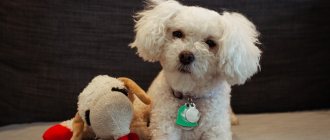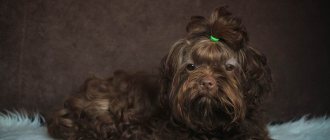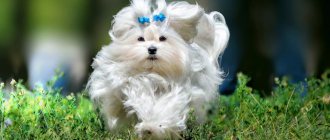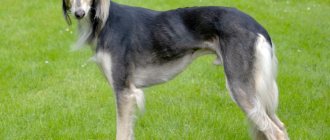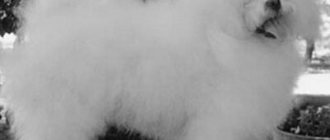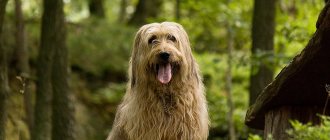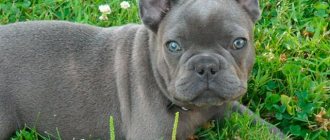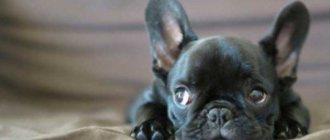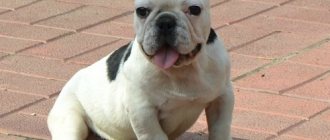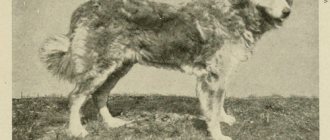Maltese dogs are miniature lap dogs with expressive, curious dark eyes, a slightly elongated body and long snow-white hair. Smart and observant little ones adapt well to the rhythm of life of their owners, but with excessive connivance they easily turn into spoiled and jealous creatures.
Let's find out what Maltese dogs are and how to make life together comfortable for both owners and their pets.
Brief history of origin
Maltese appeared so long ago that it is simply unrealistic to establish its exact origin. Finding out the history of the breed is also hampered by the fact that there are other varieties of lapdogs on the planet, each of which claims to be the oldest.
It is assumed that the name Maltese comes from the name of the island of Melita, where they lived 2000 years ago. But since the ancient Romans and Greeks called various islands in the Mediterranean Sea by this name, history again came to a standstill.
Aristotle contains references to “Meletian dogs,” which were later renamed Maltese and associated with Malta. Those ancient lapdogs may turn out to be the ancestors of modern dogs, in the formation of which small spaniels and toy poodles participated. They were popular among the Roman nobility. And merchants presented them as diplomatic gifts.
In England, they learned about Maltese dogs in the first half of the 16th century, and in the USA the dog was registered in 1888 and began to be used as a source breed for breeding American lines.
The Maltese received FCI recognition in 1955 and was classified in the Toy and Companion Dogs group of the Bichon subsection.
Description and features
The study of ancient historical chronicles makes it possible to establish that the Maltese breed is one of the oldest. Archaeologists have found stone images of her, which they say were created in the 7th-8th century BC.
The homeland of these charming creatures is Greece, or rather one of its cities, Malta. Hence their name. According to another popular version, lapdogs come from Egypt. Be that as it may, today they are distributed throughout the world.
In the 8th century, receiving a charming white mini-dog as a gift was prestigious and honorable. It was considered to have status, so it was presented as a gift only if the person was highly respected. Many people still associate the Maltese with a comfortable, luxurious life.
One of the most famous admirers of representatives of this breed was the English Queen Victoria. The maximum peak of their breeding occurred in the 30s of the 20th century. World wars had a negative impact on the population of these dogs. In 1945, only a few lapdogs remained in the world. But after just over 20 years, their numbers increased, thanks to amateur breeders.
It cannot be said that the Maltese is a hunter or a watchman. Moreover, it is ineffective to use it for battles. However, the lack of professional orientation does not prevent her from being a good companion, friend and faithful companion for her owner. This dog is purely decorative in nature. His disposition is good-natured and flexible.
Despite their small size, lapdogs surprise with their amazing intelligence. Don't underestimate their strength and intellectual potential! They will definitely surprise the owners. Owning such dogs is worth it for people who are often at home, lead a predominantly sedentary lifestyle and simply love four-legged pets.
The Maltese is a very affectionate and friendly creature, which nature has not endowed with aggression and suspicion. However, if the dog senses danger emanating from strangers near its owner, it will certainly want to protect him. Selflessness is inherent in her.
Interesting Facts
Over the centuries-old history of Maltese dogs, a lot of interesting things have happened to them:
- According to one version, the name of the breed comes not from the name of the Mediterranean island, but from the Latin word malat - “harbour”. This assumption arose due to the fact that Maltese originally traveled with sailors and were a threat to ship rats.
- There is a possibility that Maltese dogs took part in the formation of the Pekingese.
- Dogs of this breed have been the muses of many famous artists. Images of the Maltese are found in paintings by Rubens and Goya.
- Maltese dogs were the favorites of many crowned heads. Tiny snow-white dogs lived at the court of the French king Louis IX, the Spanish ruler Philip II, the English Queen Elizabeth I and Empress Catherine II.
Russian Tsvetnaya lap dog
A mixture of breeds, the first experiment in the USSR in breeding an ornamental pet . In the mid-20th century in Russia, fashionistas complained about their fate and envied French women with snow-white lapdogs on their knees. Therefore, the kennel club decided to collect all the miniature dogs known to Russian people at that time: a pair of light and dark lap dogs and a Lhaso apso. The result is a cute brown puppy with white streaks.
The work was completed in the late 50s, but the breed club appeared only in 1999, so the Russian Colored has not yet received recognition, but breeders are actively defending their position and hope for the imminent publication of the standard in the FCI
Russian colored lapdogs are chocolate, brown, black, gray with straight or curly hair. The dogs are small (up to 24 cm), weighing no more than 4 kg. In all other respects, they are typical Bichons with a long body, drooping ears, a short muzzle, and a bushy tail. The latest changes to the exterior standard were made in 2010.
Moderately active dogs that prefer comfort and family coziness. They can even live without walking, most importantly, in a friendly, loving family with children. Russian coloreds are flexible, kind and affectionate, and are never aggressive. The only disadvantage of the breed is its excessive attachment to humans; the pet literally follows its owner everywhere. The cost of the breed is 15,000-25,000 rubles.
Despite the fact that lapdogs are decorative, they need to be trained. Small dogs often manipulate their owners, damage furniture, and behave badly. In order not to turn your pet into a tyrant or a capricious child, you need to train him correctly from childhood.
4.4 / 5 ( 5 votes)
Breed description, standards, appearance
The Maltese is a proportional, harmoniously built dog with an elegant body and aristocratic posture. The first breed standard appeared in 1955; the 2015 edition is now valid.
According to this document, the purebred Maltese has the following characteristics:
- The head is wide, with a flat skull, a short muzzle, an almost invisible central groove, a convex crown and a pronounced stop. The nose is voluminous, with open nostrils and a rounded black nose. The jaws are strong, with a full set of white teeth. Scissor bite. The lips are dense and black. The upper one slightly covers the lower one and has the shape of a semicircle.
- The eyes are large, round, slightly protruding. The iris is dark ocher in color. The eyelids are tight-fitting and black.
- The ears are hanging, triangular, wide at the base, set high, fitting well to the muzzle. The outer part of the canvas is covered with thick, long hair.
- The body is moderately elongated, with unpronounced withers, level loin, deep chest and slightly curved ribs. The neck is almost vertical. The croup is wide, with a slight slope at the base of the tail.
- Limbs are straight. Elbows set straight, tightly pressed to the body. Pasterns are strong, almost vertical. The thighs are muscular, slightly inclined forward. The feet are round, well furred, with black pads and arched toes.
- The tail is gracefully curved, the tip touching the back or slightly tilted to the side.
On a note. Sometimes Maltese dogs give birth to puppies with extremely shortened muzzles. Such individuals are not allowed for exhibitions and breeding activities, but they are very photogenic and are in demand among ordinary owners.
The breed standard also contains a list of defects, the presence of which will disqualify the dog:
- narrowed or diverging lines of the skull;
- unpigmented eyelids;
- short or absent tail;
- Roman nose;
- incorrect bite;
- polydactyly;
- cryptorchidism.
Size and constitution
Maltese dogs are miniature dogs with poor sexual dimorphism. Depending on the size, there are 2 intra-breed varieties:
- Classic (Italian). It is focused on FCI standards and is considered the largest of all. The weight of a classic type Maltese is 3-4 kg, and its height varies between 20-25 cm.
- American. The appearance of these Maltese is regulated by the standard of the American Kennel Union. These lap dogs are smaller than the classic type and weigh up to 2.7 kg.
There is also a mini Maltese, whose weight is only 1.5-2.5 kg and height does not exceed 20 cm. Externally, such a dog is closer to representatives of the American type and does not meet the FCI standard. Therefore, the Micro Maltese is not allowed in exhibitions organized by the Fédération Cynologique Internationale.
Color and coat type
The Maltese breed belongs to the long-haired category. Its representatives are covered with light, straight hair, under which lies a poorly developed down. It is quite thick and has a silky texture. The Maltese's coat flows like a mantle and clearly outlines the contours of the dog's body.
Its minimum length should be 20 cm. The Maltese's tail must have a dewlap that reaches the hocks and forms a lush cascade.
Important! There should be no fuzz or protruding tufts of hair on the body of the Maltese dog. The exception is the inside of the front and hind legs. On these parts of the dog's body, feathering and trousers are acceptable.
According to the standard, the Maltese dog can only have a white color or ivory-colored coat. All other color variations are considered unacceptable.
Health and life expectancy
Maltese were formed with minimal interference from breeders. Therefore, they have good health and good heredity. Maltese dogs live on average 12-15 years and rarely get sick.
The most common health problems for Maltese include the following pathologies:
- dislocation of the kneecap;
- digestive problems;
- hypoglycemia;
- blindness;
- dermatitis;
- tracheal collapse;
- allergy;
- heart disease;
- hydrocephalus;
- deafness;
- ophthalmological diseases.
On a note. The baby-face Minimaltese is weaker than its standard counterparts. Due to the specific structure of the skull and insufficient weight, such dogs are more likely to get sick and injured.
Health
Maltese are generally healthy, but like all breeds they are susceptible to certain diseases.
- Patella luxation in dogs (patella) : This is when the knee joint (often the hind leg) becomes dislodged, causing pain.
- Portosystemic liver shunt: This liver disease occurs when an abnormal vessel causes blood to bypass the liver and therefore not be cleared.
- Progressive retinal atrophy (PRA): a degenerative eye disease. PRA blindness is a slow process that results from the loss of photoreceptors in the back of the eye.
- Hypoglycemia: This condition is caused by low blood sugar levels. Some of the signs may include weakness, confusion, unsteady gait and seizures.
- White Dog Shaker Syndrome: This is a condition that primarily affects white dogs. Signs of this condition include tremors throughout the body, poor coordination, and rapid eye movements. Symptoms usually appear when the dog is between six months and three years old and is stressed or overly excited.
- Tracheal Collapse: Some dogs are prone to this condition in which the trachea, which carries air into the lungs, tends to collapse. The most common sign of tracheal collapse is a chronic, dry, harsh cough, which many describe as sounding like a "goose whistle."
- Reverse sneezing: Sometimes confused with tracheal collapse, this is a much less serious condition that lasts only a few minutes. Reverse sneezing usually occurs when your dog is excited or tries to eat or drink too quickly. It can also happen when there is pollen or other irritants in the air. Discharge from the dog's nose falls onto the soft palate, causing it to automatically close over the trachea. Lightly stroke his throat to help him relax.
Character and behavior
The Maltese is a perky, friendly dog that can maintain puppy playfulness for a long time. In the family, she singles out one owner, and treats other household members as equals. Maltese loves attention and cannot be left alone for long. From lack of communication with its owners, the dog becomes nervous and acquires bad habits.
The Maltese is confident in its own superiority and gets along well with other pets. A cheerful and mischievous dog regards them as potential play partners, but can compete for the attention of its owners. If the owner pets another animal, the Maltese turns into a jealous fury, ready for meanness.
The Maltese is wary of strangers and perceives them as a potential threat. The dog rushes towards any guest with a loud, menacing bark. Of course, a miniature Maltese cannot cause serious damage, but it will certainly make noise and scare away an intruder.
Breed and children
Judging by the photo of an adult lapdog, it seems that this dog is ideal for families with children. In fact, the Maltese is not the best choice for people with babies. Preschool children can inadvertently injure a tiny dog or provoke it into aggression with their importunity.
The Maltese will easily get along with teenagers and become an ideal companion for walks together.
Bichon Frize
The breed appeared a long time ago, in the 13-14th century on the Canary Islands. The animals were not specially bred. The sailors found small white curly dogs in the tropical forests and decided to bring them to the mainland. During the voyage, the Bichons showed hunting qualities: they boldly hunted rats and mice in the holds, and protected provisions. Therefore, the sailors kept some of the individuals for themselves, and sold others to Europeans.
Canary Bichons found their way to Spain, Italy, England and France. Each country improved dogs in its own way. The Bichon Frize is a French breed that is loved not only by aristocrats, but also by street performers. Dogs can be found on circus posters or paintings from the 15th to 18th centuries.
Curly light coat is a natural necessity. This cover repels the sun's rays and does not accumulate heat. This was the inspiration for the name of the breed: frize from French - curly.
Despite the fact that dogs are considered decorative, they are much denser, larger and heavier than “sofa” pets. Bichons are larger than Chihuahuas or Toy terriers and can grow up to 30 cm and weigh more than 5 kg. In addition, springy curly hair (up to 10 cm, corkscrew curls) adds volume. The only acceptable color is white; red spots are typical only for puppies.
Active, positive, cheerful dog. An ideal family pet that values and loves all members of the household equally. Bichons are kind, flexible, and get along with children. They like games and sports.
Thanks to their mental abilities and physical fitness, Lapdogs can cope with any task. They show good results in agility, circus work, and freestyle. The main drawback of the breed is playfulness. Bichon Frizes love to chew and break everything. The cost of puppies is up to 50,000 rubles.
How to choose a pet
The Maltese is a popular breed that scammers often want to make money from selling. To avoid getting a sick or purebred dog as a pet, you need to contact professional breeders or registered kennels.
When choosing a Maltese puppy, it is advisable to look at several litters and ask in advance:
- presence of documents and stamps;
- health status;
- conditions of keeping the mother and puppies.
Pedigree Maltese puppies must have:
- dark eyes;
- black nose;
- white color;
- straight, not too fluffy coat.
On a note. Maltese puppies have a slightly wavy coat that will straighten out as they mature. But strong curls are considered a defect and are unlikely to disappear with age.
Before making the final choice, you need to observe the behavior of the Maltese puppy you like. He should be moderately curious, friendly and sociable.
Coton de Tulear
The second name of the breed is Madagascar Bichon. The Bolonki Islands arrived from France in the 17th century. There is a legend that after a shipwreck near the port of Tulear, several dogs survived and bravely swam across the rest of the strait and ended up on the island, where they mixed with aboriginal mongrels. This is how the unyielding, brave, fearless Bichons turned out - Coton do Tulear (the first part of the name is translated as “cotton” from French).
The Africans found the dogs, tamed them, washed them and sent them to the sea - on ships to serve as rat catchers. This is how the Tulears, called “kings of Africa,” would have sailed if the pampered Europeans had not noticed them and taken them to their palaces.
Like all Bolonki, Cotons are small (up to 28 cm at the withers), stocky, dense, but graceful and graceful, with long ears, a high tail and a royal posture. Their distinctive feature is long gray or ashy spots among the curls of flowing, wavy white coat. Due to their short, thick limbs, Tulears have to jump with four legs rather than two.
Animals will follow their master into fire and water. They are ideal companions with good physical fitness, hardy, courageous and cheerful. Dogs know how to adapt to their owner: they are ready to entertain children, relax with an elderly person, go for a run in the morning or lie on the couch all day.
The breed is hardened by hot climates and work, so Cotons still exhibit survival instincts to this day. They can strangle a rodent or bark at a stranger. It is important for them to protect the owner and his property.
Dogs are valued for their intelligence, willingness to train and learn. But if training is not started on time, puppies become fearful, withdrawn and uncommunicative. The average cost is 35,000 rubles.
Puppy care
A Maltese puppy from a good nursery moves to a permanent place of residence no earlier than 2.5-3 months. Therefore, future owners have time to prepare. To make the life of a Maltese dog comfortable, purchase for it in advance:
- toys;
- sleeping area;
- harness and leash;
- hygiene products;
- grooming tools;
- bowls for food and water.
For safety reasons, wires, medicines, household chemicals and indoor plants are hidden in the house where the Maltese puppy will live. And to prevent your baby from ruining the carpets, it is better to remove them until he is toilet trained.
After arrival, the puppy is given time to adapt and allowed to become familiar with its new home. The Maltese baby must be shown where he can eat and rest. And so that he does not experience separation from his mother so acutely, a little thing with the smell of his native “nest” is placed on his sleeping place.
When the Maltese puppy gets used to its owners, it is taught to be calm about hygiene procedures and adhere to the rules of behavior.
To prevent the baby from growing up spoiled, he is not allowed to:
- bite;
- beg;
- sleep on upholstered furniture.
So that you can walk with your Maltese puppy and not be afraid that he will get an infection, he is vaccinated. The baby is vaccinated with a complex drug:
- from plague;
- rabies;
- parainfluenza;
- leptospirosis;
- parvo and coronavirus enteritis.
The first vaccination for a Maltese puppy is given at 8-9 weeks and repeated after 21 days. Before this, he is given anthelmintic drugs, the dosage of which is calculated strictly by weight.
It is recommended to carry out antihelminthic treatment of Maltese twice with a break of 10-14 days.
Comparison with other small dogs
It is most relevant to compare the Maltese with other small breeds that have at least some similarities with each other. So, for example, lap dogs are a little similar to Yorkshire terrier dogs. They also have long hair, which requires proper care, and expressive, dark, round eyes. But there are a number of differences:
- smaller Yorkie;
- A terrier can be of different colors, but a lapdog can only be white;
- There are many restrictions in the Maltese's diet and a special approach is required, while Yorkies are absolutely not picky about food.
Yorkshire Terrier in the photo:
If we compare the Maltese and the Bichon Frize, the similarities between them lie in their pretty appearance, white color and character. Both breeds are very friendly, affectionate and loyal. But there are also quite obvious differences between them:
- The lapdog's coat is long and smooth, while the Bichon Frize's coat is curly and elastic;
- The lapdog is smaller in size than the bichon; the height at the withers of the latter can reach 30 cm;
- The price of Maltese puppies is higher than that of Bichon Frize.
The Shih Tzu breed is considered as popular and expensive as the Maltese. Both breeds require special coat care. The Shih Tzu weighs almost twice as much as the lapdog. Adult dogs weigh 6-8 kg, but their height at the withers is only a few centimeters higher than that of the Maltese (28 cm for the Shih Tzu).
Important! The Maltese shows devotion to one owner, and the Shih Tzu communicates equally with all family members.
The Shih Tzu breed is characterized by a wider palette of shades, in contrast to the Maltese's exceptional white color.
The Maltese, like many small dog breeds, is very popular. The friendly nature and compact size make it possible to keep the dog in an apartment and even in the presence of children. She gets along well with other family members and is calm around other animals. Maltese mixes with other breeds of small and medium-sized dogs are no less cute and affectionate.
Care and maintenance
The mini and standard Maltese belong to the decorative breeds. She is not suitable for street life. These dogs love comfort and are ideal for home keeping. Caring for a Maltese comes down to regular grooming, proper feeding and timely veterinary care.
Hygiene procedures
In order for the Maltese to have a neat appearance, it is provided with appropriate care:
- The dog's teeth are cleaned 2-3 times a week with a silicone brush and a small amount of special paste. To prevent plaque from appearing on them, your Maltese can be given chewy treats.
- The dog's ears are wiped weekly with a cotton swab dipped in a special lotion. They are also regularly checked for unusual discharge. If any suspicious symptoms appear, the dog is shown to the veterinarian.
- The eyes of the Maltese require special attention. They are wiped daily with a cotton pad moistened with boiled water and inspected. If redness, excessive dryness or increased tearing is detected, the dog is scheduled for a consultation at the clinic.
- As they grow, the Maltese's claws are carefully shortened with a nail clipper so as not to touch living tissue.
- The show dog's coat is washed weekly using a special shampoo and conditioner. Then the Maltese coat is blotted with a towel, dried with a hairdryer and rolled into curlers. If the dog is not a show dog, then it gets a nice haircut.
- Brush your Maltese dog daily. To begin with, carefully sort the dog's fur with your hands and, if necessary, untangle the tangles. Then it is sprinkled with talcum powder and combed with a fine-toothed metal comb. The Maltese's "bangs" are gathered into a ponytail and secured with a hairpin or elastic band.
Feeding
Maltese dogs need adequate nutrition. Dogs of this breed should not be overfed. Otherwise, they begin to gain weight and develop health problems.
The Maltese should be fed strictly on a schedule taking into account its age:
- up to 8 weeks – 5-6 times a day;
- 2-6 months – 4 times a day;
- 6-12 months – 3 times a day;
- over 12 months – 2 times a day.
Industrial feed
Some types of dry food cause allergies in Maltese dogs. Therefore, they are selected individually. Maltese eat well the following brands of dry food:
- Josera;
- Brit Care;
- Hills;
- Grandorf.
Important! When purchasing dry food for Maltese, preference is given to imported super-premium products for miniature breeds or for dogs prone to allergies. It is advisable that it does not contain soy, chicken, dyes, corn, wheat and other dubious additives.
Natural feeding
With this type of diet, half of the Maltese's diet should be lean meat such as rabbit, turkey or lamb. It is not advisable to give chicken and beef to a dwarf dog because they can cause allergies.
In addition to meat, the Maltese dog’s diet must be supplemented with:
- cereals;
- vegetables;
- giblets;
- sea fish;
- fermented milk products.
In order for the Maltese to remain healthy longer, the following will be removed from its menu forever:
- beans;
- spices;
- pork;
- confectionery;
- any food from the master's table.
Walking and exercise
Although the Maltese is an indoor breed that can be trained to use a litter tray or diaper, it needs fresh air. It is better to walk such a dog in warm and dry weather. And in rain or mud, the Maltese can be dressed up in waterproof overalls.
On a note. Maltese dogs get tired quickly from walking, so their duration should not exceed 30 minutes.
Training and education
Maltese dogs do not need special training, but they must know basic commands. These small dogs are quite stubborn and quickly acquire bad habits. Therefore, raising a Maltese needs to be done from an early age.
On a note. To prevent your Maltese puppy from getting tired and losing interest in activities, they should be short and varied.
In order for a Maltese to learn to relate calmly to the world around it, it must be socialized. From an early age, the dog is taught not to react to street noise, strangers, other animals and vehicles.
Training and education
The Maltese is not at all like the large fighting dogs that have been trained since childhood. But this does not mean that there is no need to train the animal. Its socialization and training also need to be done from the first days of the pet’s stay in the house. By 2-3 months, the puppy should normally respond to its name and know several basic commands.
The establishment of prohibitions plays an important role in education. If something is prohibited for a pet, household members need to support these rules. Do not give your dog forbidden food or let him sleep on the sofa, no matter how tearfully he asks.
The basis of any training is patience and reinforcement of correct actions. If the owner speaks rudely to the pet, this can discourage any desire to learn and offend him for a long time. In order for socialization to be successful, the Maltese, while still a puppy, must be walked in special places intended for dogs. This will help the animal calmly perceive the environment.
There is a myth that small dogs should not be trained, but this opinion is not only wrong, but also dangerous. An untrained animal is at great risk on the street.
Puberty and mating
The first heat in Maltese dogs begins at 6-12 months. But dogs older than 15 months and younger than 9 years are allowed for breeding. To obtain viable offspring, only completely healthy and vaccinated Maltese dogs are used, the exterior of which corresponds to the breed standard.
Mating is carried out in the male's territory and repeated the next day. Before mating, the dogs are not fed and allowed to get to know each other. If everything goes well, then after 58-64 days the Maltese will give birth to healthy puppies.
Reproduction and lifespan
These charming creatures serve their owner for at least 14-15 years. With good care, they can live up to 16 years. The breeder must take the issue of breeding Maltese dogs seriously. Here are some tips that will allow you to organize the mating of a dog and a bitch:
- It is better to place individuals on his territory, this will reduce the risk of the male being rejected by the female.
- Only adult dogs, at least 2 years old, are selected.
- At the time of mating, the female must have been menstruating for at least 3 days. This makes her more likely to get pregnant.
- You should not change the diet of a presumably pregnant lap dog. It is important to limit her activity so that she does not become overtired.
Be prepared to give birth to her a maximum of 73 days after mating. If you have never done this yourself before, or are afraid, it is better to trust a professional.
Maltese price
The price of a Maltese depends on many factors and varies widely.
- The most expensive dog is the Maltese dog with show prospects and an elite pedigree. The price of such a puppy can reach 80 thousand rubles.
- A purebred dog with documents but a mediocre exterior costs about 20 thousand rubles.
- Maltese mini or baby face can be bought for 35-45 thousand rubles.
Maltese dogs are adorable dogs with a luxurious white coat that contrasts sharply with their dark eyes and black nose. Good-natured mischief-makers attract admiring glances and will become wonderful companions for those who are not too lazy to care for their luxurious fur coat.
Pros and cons of the breed
| pros | Minuses |
| There is practically no shedding | No pronounced security and watchdog qualities |
| Gets along well with children and pets | Requires constant care for coat and eyes |
| Does not require much physical activity | Sometimes he may bark for no reason in the apartment. |
| Easily trainable | |
| Possibility of living in an apartment | |
| Can do agility |
Where to buy and price
The cost of a puppy primarily depends on the availability of a pedigree.
The best way to purchase a pet with famous parents is in special nurseries:
- Black Diamond (Moscow region);
- Sax-Leons (Krasnodar);
- Malyutka (Moscow);
- Vart Royal Escort (St. Petersburg).
The price of a purebred puppy with documents can cost about 20,000 rubles. The cost of exhibition animals starts at around 45,000 and can reach up to 80,000 rubles.
The Maltese can become a wonderful companion and a true member of the family. This kind, smart, affectionate dog captivates others with its appearance. If the owner is ready to maintain this beauty, not to skimp on time and love, then the Maltese will be an excellent choice.
Nutrition
In order for the Maltese dog to develop properly, to be full of strength and energy, and to maintain health for many years, it is best to give it special dry food. Its manufacturers guarantee the balance of all components and compliance with all the necessary proportions of microelements and vitamins in it.
It is advisable to consult a veterinarian and check reviews about the manufacturer before choosing food. In addition, it must be selected according to age and individual characteristics.
But there are dog owners who do not trust dry food and prefer to prepare food for their pets themselves. In this case, the main thing is not to forget to add the necessary minerals and vitamin complex to the dog’s diet. This will help keep your dog in great shape.
Maltese dogs can be given poultry, beef, chicken eggs and various vegetables. Mixes and mixtures can be made from these ingredients. In addition, fish is sometimes introduced into the diet, which must be pre-cooked. Various cereals are also served with fish. For example, buckwheat or rice.
In addition to what to give your dog, you also need to know how to do it correctly. It is not recommended to keep a bowl of food on the floor all the time, that is, put a portion on the floor. After eating, he cleans up and washes himself. Next time everything is repeated again.
In addition, it is better not to leave food in the dog’s plate in reserve. Meals should be on a schedule. Adults need to break their food intake into 2 stages. At the same time, in the morning, porridge is given with milk, water or meat broth with the addition of pieces of chicken or beef.
Maltese puppy
In the evening - mixes of meat and vegetables, as well as eggs or fish. Portions should be small so that the dog does not gain much weight. Since this will have a bad effect on the functioning of her internal organs. In addition to standard dishes, the Maltese dog can sometimes be rewarded with treats. You can buy them in specialized stores.
Pregnancy and childbirth
Puberty in a dog occurs on average at 1-1.5 years. The first mating should occur no earlier than 1 year and 3 months.
Pregnancy lasts approximately 3 months. At this time, the lapdog requires special care and support. Vitamins and other biologically active substances should be added to food.
It is recommended to carry out childbirth in the presence of a veterinarian in a hospital or at home. If there are no diseases, you can breed a dog every year.
Feeding a decorative breed
You can feed your lapdog both natural food and dry food. The main thing is not to overfeed and follow the recommended age standards.
If the dog is naturally fed, then half of the diet should be meat, and the other half should be rice, buckwheat, vegetables and fruits. Fermented milk products should also be present in the diet.
Important! Smoked meats, chocolate, legumes, potatoes, sharp cheeses, pickles and cabbage are harmful to lap dogs.
Dry food is selected on the recommendation of a veterinarian, because some industrial food can provoke an allergic reaction.
Owner reviews
Owners of lap dogs usually leave positive reviews about their pets, some of which should be cited:
Dve4 (Russia, Moscow):
We purchased this charming creature for our child. And with his appearance in our house there was one more smart creature. The adorable puppy turned out to be not only cute and charming, but also very smart. I quickly got used to the place and immediately understood where I needed to do my business. There are no problems with food either - he eats dry food just fine.
Rekales (Russia):
We bought the puppy quite a long time ago; he was smart, obedient and funny – he charmed our whole family at once. We looked after him according to all the rules, fed him as expected, maybe that’s why he lived with us for 17 years. Everyone was very sad after he passed away.
